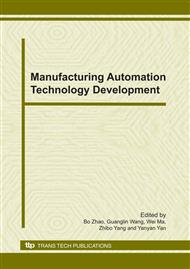p.616
p.621
p.625
p.632
p.637
p.643
p.648
p.653
p.658
The Machined Surface Residual Stress of Nano-Ceramics with Two-Dimensional Ultrasonic Vibration Assisted Grinding
Abstract:
Surface plastic deformation form and residual stress distribution of nano-ceramics machined by ordinary grinding and two-dimensional ultrasonic grinding respectively were investigated. The obtained results show that machined surface residual stress in the two grinding modes is extrusion stress, and it decreased with the increasing of grinding depth. But the decrease of residual stress under two-dimensional ultrasonic grinding is less than that under normal grinding. In addition, under the same grinding parameters, the surface residual stress on two-dimensional ultrasonic vibration grinding is larger than that on ordinary grinding, and if other parameters unchanged, it is increased with the increase of wear particle granularity in the two grinding modes. It is produced by the reason that ductile regime of ceramic grinding become larger under ultrasonic grinding, so that material is still removed by plastic form at great depth. Plastic removal mode will produce greater surface extrusion stress, so with the increasing of grinding depth, the decreasing of residual stress under two-dimensional ultrasonic vibration grinding is less than that under the normal grinding. At the same time, the regular separating between wear particle and work piece improves the heat emission condition, which is also one of the reasons that the surface residual stress under two-dimensional ultrasonic grinding is larger than that under ordinary grinding.
Info:
Periodical:
Pages:
637-642
Citation:
Online since:
December 2010
Authors:
Price:
Сopyright:
© 2011 Trans Tech Publications Ltd. All Rights Reserved
Share:
Citation:


